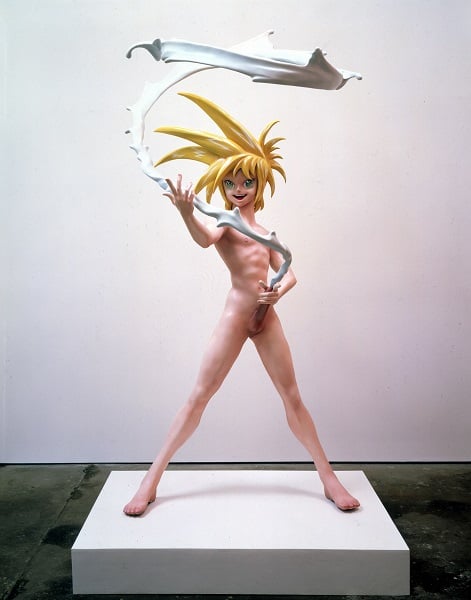Art & Exhibitions
How Erotic Can Fine Art Get Before it Becomes Pornographic?
Women get off in Clayton Cubitt's Videos at MASS MoCA.

Women get off in Clayton Cubitt's Videos at MASS MoCA.

Brian Boucher

Steamy videos of women getting off while reading books go on view in a show opening this month at the Massachusetts Museum of Contemporary Art (MASS MoCA).
Clayton Cubitt’s “Hysterical Literature” series depicts women seated at a table reading a book of their choice. Each woman introduces herself, identifies the text she has chosen, and begins to read. As she does so, someone unseen under the table stimulates her with a vibrator.
The women’s increasing arousal is evident as they lose track of the text, gasp, and clutch the table, before they climax, come down, and restate their names and chosen texts. Simple enough, right? It may sound gimmicky, but the work makes you think about how erotic fine art can get before it starts to seem like it’s really just erotica, about definitions of pornography, and whether depictions of women’s pleasure, filmed by a man, can be a feminist project. As one of the participants writes, the project enables women to “express our sexuality without surrendering our agency.”
The exhibition isn’t just about sex, though, let’s remember. It’s about libraries. “Bibliotecaphilia” opens January 24 and includes five artists in addition to Cubitt: Jonathan Gitelson, Susan Hefuna, Meg Hitchcock, Dan Peterman, and Jena Priebe. Curated by Allie Foradas, a graduate student in the Williams College Graduate Program in the History of Art (which, for the record, this writer attended), the show asks whether we still love libraries in the age of the e-book, and what new forms libraries might take in the digital era.
Gitelsen’s work, Marginalia, offers shelves of books marked up by previous readers to highlight the physical traces left by others after they’ve experienced a text. Meg Hitchcock, meanwhile, has made works that employ letters from one holy text to spell out the verses of another religion’s holy book, suggesting a reconciliation between competing worldviews.
There’s a tradition of artists taking libraries as their subjects. Martha Rosler put her book collection on view at New York’s e-flux space in 2005-06; Meriç Algün Ringborg, in a 2013 project for New York’s Art in General, created a “Library of Unborrowed Books,” volumes that had never been checked out from the collection of Manhattan’s members-only Center for Fiction.
But let’s talk about sex, shall we?
Cubitt’s been shooting his videos (there are currently nine) since 2012, and his site says they’ve been watched over 30 million times. But this is the first time they’re appearing in an art museum. Cubitt hasn’t gone without notice in the art world. He’s shown work in group shows at Larissa Goldston Gallery and Envoy Gallery (both in New York) while also working as an editorial photographer with clients like Vogue and Rolling Stone. According to his website, he’s done advertising work for Converse, Microsoft, and HBO, among other corporate clients.
One of his readers is an “adult performer,” one works in fashion, one is an actress and comedian, and several are artists. Stoya, the “adult performer,” reads an excerpt of Supervert’s book Necrophilia Variations, which the author’s website describes as “a literary monograph on the erotic attraction to corpses and death.” (Supervert also has a book about the “erotic potential of alien life.”) Alicia reads from Walt Whitman’s poem “Leaves of Grass.” Solé reads Toni Morrison’s Beloved. The selections are not exactly Fifty Shades of Grey, to Cubitt’s and the performers’ credit.
The videos are both funny and hot. The contrast between cerebral and carnal is amusing. To avoid any associations with pornography, the videos are in staid black-and-white. The project also provocatively touches on female desire and sexual pleasure, which, as feminist critics and theorists have often pointed out, tends to make people, uh, uncomfortable.
Cubitt is also a commercial photographer who has shot portraits of subjects ranging from New Orleans mayor Ray Nagin to artists including Dan Graham and David Byrne, and musicians including Ninja from Die Antwoord and rapper Rick Ross. According to an “FAQ” page on the project’s website, the orgasm videos aim to “short-circuit the practiced poses of modern media-savvy portrait subjects.”
“Hysterical Literature” isn’t the first artwork to show women experiencing le petit mort, as the French call it. Gianlorenzo Bernini’s The Ecstasy of St. Teresa (1644-47) is the greatest example. But actually, it’s hard to think of others.
Men surely get off in art. Andy Warhol’s 1964 video Blow Job shows a man’s face as fellatio is supposedly administered by an unseen partner. (In a version viewable on Vimeo, it’s ambiguous whether the orgasm, if it even happened, is actually shown. The screen goes momentarily blank, after which the performer lights a cigarette.) Takashi Murakami’s 1998 sculpture My Lonesome Cowboy shows an ejaculating male figure whose semen rises in an unbroken stream to form a lasso-like shape above his head.

Takashi Murakami, My Lonesome Cowboy (1998).
Photo: Courtesy of Blum & Poe, Los Angeles
The list of artists who have brought sex into art is too long to enumerate, with some more obvious examples being Jeff Koons, Vito Acconci, Karen Finley, and Annie Sprinkle.
In 2002, in a comment on artists’ implication in the market, Andrea Fraser had sex with an unidentified collector who reportedly paid $20,000 for the privilege. The hour long resulting video depicts the sexual encounter taking place at New York’s Royalton Hotel. No word on whether Fraser got off.
So check out Cubitt’s videos and decide for yourself about how you’d define them: sexy art, arty porn, or erotica. If they’re too sexual to qualify as high art for you, though, take another look at Bernini’s Saint Theresa with her eyes rolled back, and her mouth agape in pleasure and tell me she’s not getting off too.